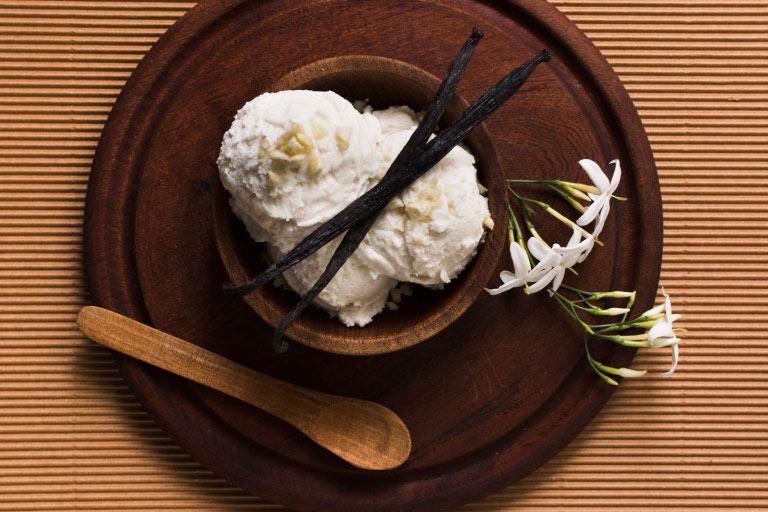
Vanilla
What is Vanilla?
Vanilla flavoring is a dark brown color and grows in the form of a long pod. It is the fruit of types of orchid plant that thrives in tropical regions. Commercial vanilla beans are the unripe and dried fruits of Tahitian vanilla (V. tahitensis), Mexican or Bourbon (Vanilla planifolia), and sometimes West Indian vanilla (V. pompona). All three species are derived from native species in Mexico, Central America, and northern South America. In total, there are more than 110 species of vanilla orchids, but only Vanilla planifolia produces fruit that is used to make 99% of commercial vanilla. The seeds of this flavoring have the most intense aroma and taste sweet or smoky.
Appearance Properties of Vanilla
The pods of its dried seeds are dark brown or black. Due to vanilla ice cream and its distinctive flavor, you might think this substance is white, but its seeds are dark brown to black, and the extract is usually amber to dark brown and slightly cloudy. Since this flavoring has a very strong flavor and aroma, a very small amount is highly effective.
Types of Vanilla Extract
Most vanilla beans are converted into extract, which is a common ingredient in baked food products. There are two different types of vanilla extract: pure and synthetic. The pure extract is derived from natural beans and has a more unique and complex flavor. On the other hand, the synthetic extract is made from vanillin, the main flavor compound in vanilla. While synthetic extract is cheaper, it does not possess the purity and aroma of pure extract. Pure vanilla extract contains several chemical compounds, including vanillin, acetaldehyde, acetic acid, furfural, etc., and each of them has different effects on baking. Vanillin is the main compound of vanilla and its sweet aroma is obtained from this compound. Acetic acid, a byproduct of fermentation, helps activate baking soda or baking powder in cake batters, creating carbon dioxide bubbles that help the cakes to puff up. In reality, most of the vanilla we consume is not pure but synthetic.
History of Vanilla
As a flavoring and fragrance, vanilla held a special place among the ancient Maya, Aztec, and Totonac cultures of the Americas. The Aztecs combined vanilla with a chocolate drink called Xoco-lall. Spanish conquistador Hernán Cortés sampled this chocolate drink and brought it back to Spain. Although vanilla is now used in various products, it was primarily an additive for chocolate for centuries. It gained its independence from chocolate in the early 17th century, when an apothecary created a vanilla-flavored, chocolate-free confection for Queen Elizabeth I. In France, it quickly became a favorite flavor in ice creams. For a long time, Mexico was the sole exporter of vanilla, as only native Mexican insects could pollinate the plant. But after some time in 1836, the Belgians discovered a method for pollination, so Europeans quickly began cultivating vanilla. In 1870, the French colonies of Bourbon and Madagascar had become the world's largest producers, with vanilla from this region becoming known as Bourbon vanilla.
Applications of Vanilla in Food and Cosmetic Industries
This amazing ingredient has diverse applications in the food and fragrance industries. Some examples include:
- It is widely used in dairy products, especially in ice creams. Vanilla ice cream is the most popular flavor in the United States and accounts for 28% of the ice cream produced per year.
- This additive is one of the main flavorings in baking, creating a distinctive taste and enhancing the aroma of other ingredients. In addition, it affects the appearance and texture of the cake and covers the bitter taste caused by leavening agents, flour, or cocoa.
- It is used in beverages such as syrups and even soft drinks.
- Vanilla plays a key role in chocolate production, especially in solid chocolate bars, where powdered vanillin is frequently used.
- It is also used in candies, cornflakes, puddings, and sweet sauces.
Vanilla's application is not limited to food industries. It is famous in the perfume industry due to its warm and pleasant fragrance. Its relaxing and sweet notes have made it a popular choice in perfumes for centuries. Yekta Shimi Azma Company extensively works on vanilla and supplies this wonderful substance.
How Much Vanilla is Safe?
Vanilla is generally recognized as safe and even has benefits for the health body. This additive is a natural antidepressant, so it contains active compounds that stimulate serotonin production. This can reduce anxiety, promote well-being, and improve mood. Vanilla tea can also soothe digestive issues. One traditional remedy for vomiting and stomach discomfort is boiling water with vanilla beans. The rich aroma of vanilla is effective in reducing bloating. However, people typically do not consume this extract in large amounts because it will not have a pleasant taste in large quantities and may cause stomach discomfort in high doses. It is recommended to avoid overconsumption, as it may cause skin irritation and swelling in some individuals. In those with sensitivities, it can also lead to headaches and insomnia. The technical team of Yekta Shimi Azma Company is proud to offer solutions and technical information about this highly useful additive.

